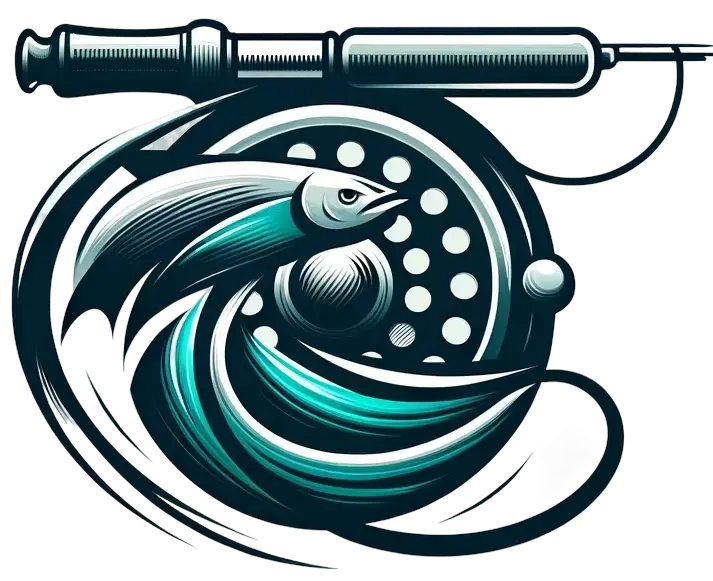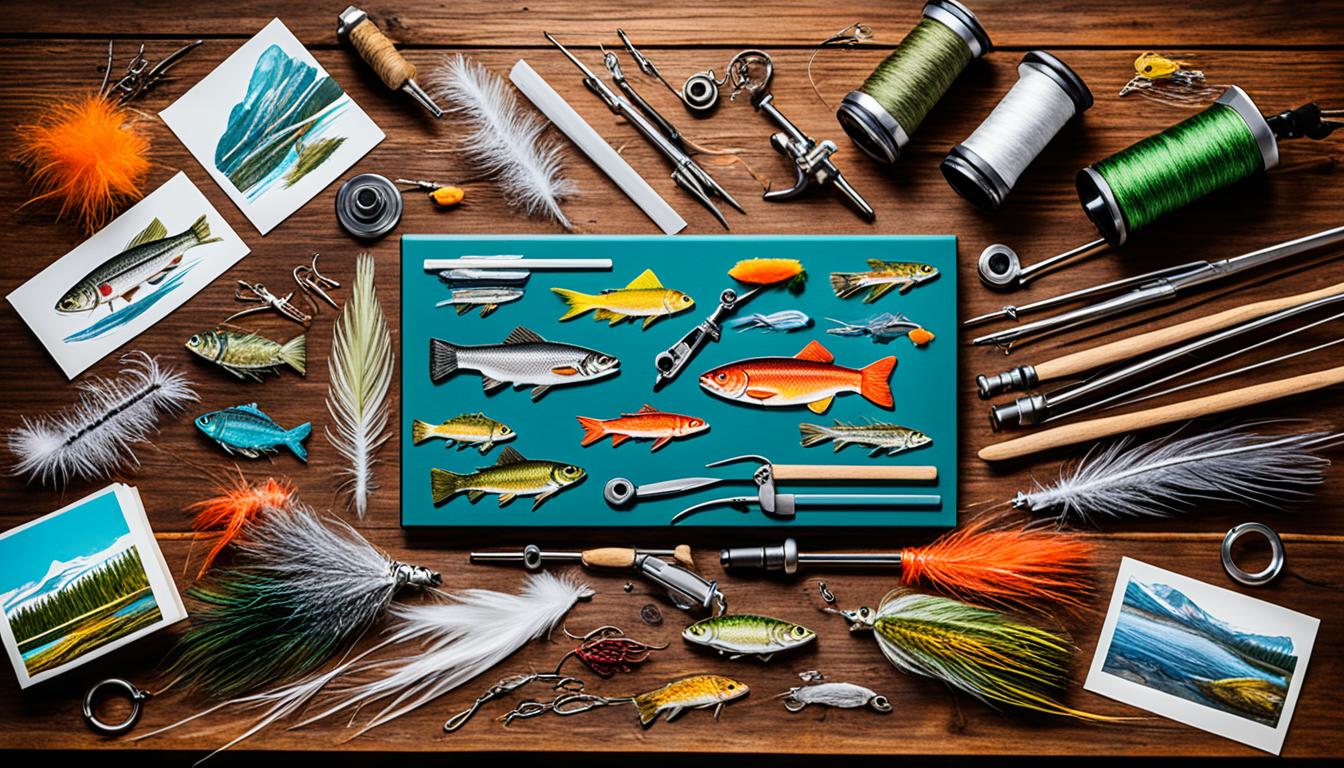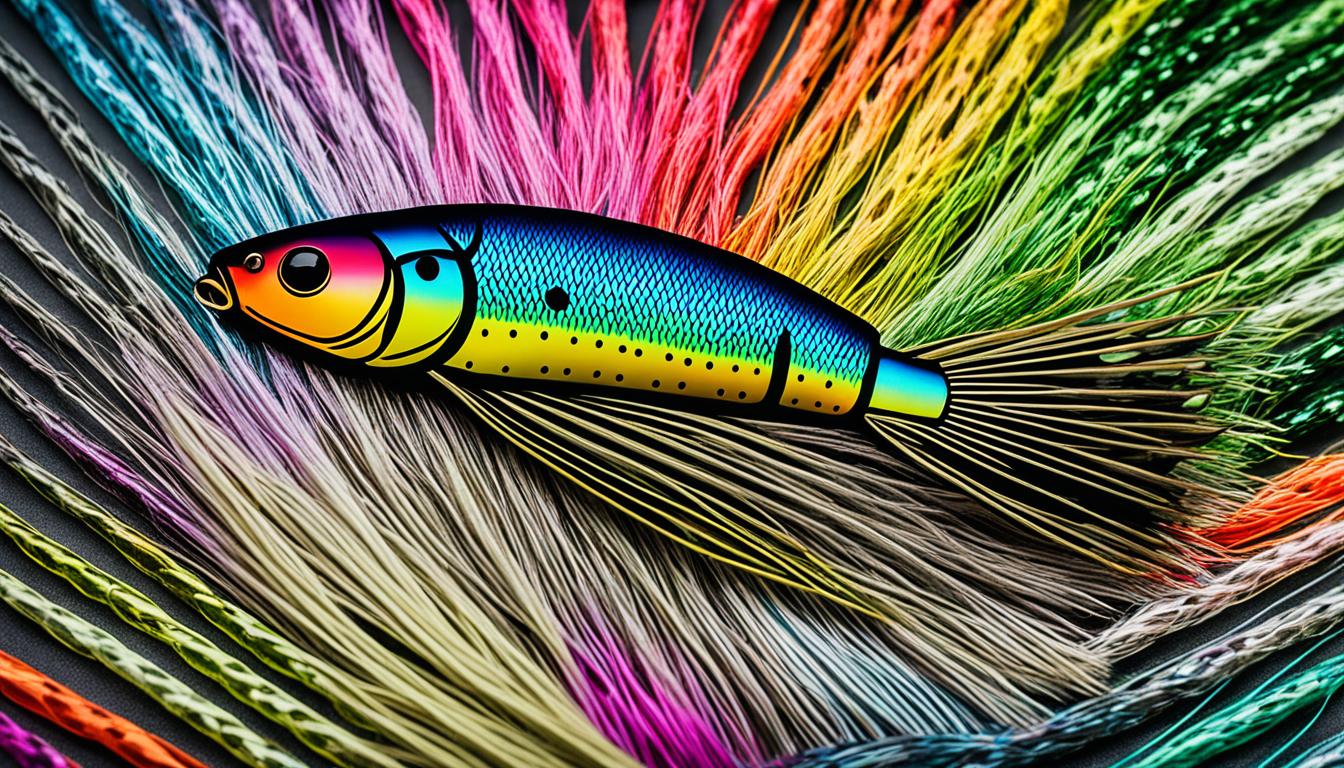Welcome to our guide on Mastering Streamer Ties: Tips for Perfect Flies. Whether you’re an experienced angler or just starting out, streamer fly tying is a valuable skill to have in your repertoire. In this article, we will share some pro tips and techniques that will help you take your streamer fly fishing to the next level.
Streamer fly tying involves creating flies that imitate small fish, baitfish, or other prey that larger fish feed on. These flies are typically larger and designed to attract big fish. By mastering the art of streamer fly tying, you can increase your chances of landing trophy-sized trout, bass, and other species.
Key Takeaways:
- Learn the passive streamer technique for slow retrieves and natural movement.
- Use synthetic materials like Polar Flash and Murdich Minnow for effective streamer patterns.
- Expand your fly tying skills beyond the Woolly Bugger to create more intricate and realistic flies.
- Pay attention to proportions, repetition, and consistency when tying streamer flies.
- Experiment, observe, and refine your techniques to develop your own style and patterns.
The Passive Streamer Technique: An Unconventional Retrieve
In our pursuit of perfect flies, we are constantly searching for innovative techniques to outsmart fish. One such technique that has gained popularity among fly anglers is the passive streamer technique. Inspired by conventional tackle tactics used in bass fishing, this method offers an unconventional retrieve that can entice even the most finicky fish.
The passive streamer technique involves a slow retrieve with frequent pauses, mimicking the movement of natural prey like crayfish and sculpin. By imitating the subtle and deliberate actions of these underwater creatures, we can trigger strikes from wary fish.
When employing the passive streamer technique, one fly that stands out is the Meat Whistle. This fly is specifically designed for this retrieve and is tied on a jig hook with bead-chain eyes, allowing it to ride hook point up. The combination of the right hook, cone, and dressing enables the fly to fish near the bottom and maneuver through weeds and debris with fewer hang-ups.
To make the passive streamer technique even more effective, it’s essential to pair it with the right equipment. Using a floating line and a long leader will help lift the fly during retrieval and keep the line on the surface while the fly is near the bottom. This combination creates a natural presentation and increases your chances of enticing strikes.
| Fly: | Meat Whistle |
|---|---|
| Hook: | Jig hook |
| Eyes: | Bead-chain |
| Presentation: | Near the bottom with a slow retrieve |
By mastering the passive streamer technique, we can unlock new possibilities for success in our fly fishing adventures. Give it a try and see how this unconventional retrieve can entice even the most elusive fish.
Stay tuned for the next section where we will delve into the art of detecting strikes with the passive streamer technique.
Detecting Strikes with the Passive Streamer Technique
In order to detect strikes effectively when using the passive streamer technique, we need to closely observe the line and pay attention to subtle changes in line tension. By utilizing visual cues and tactile sensations, we can increase our chances of detecting strikes and successfully hooking fish.
One method of detecting strikes is to watch the floating line as the fly sinks. Keep an eye out for any abrupt movements or deviations in the line’s path, as this could indicate that a fish has taken the fly. Additionally, the tip of the line or any pronounced curves can serve as visual indicators of a strike.
Another technique for detecting strikes is by feeling line tension through the fingertips. As the fly sinks or swims slowly during the passive retrieve, pay attention to any subtle changes in tension. A slight tug or resistance on the line could be a telltale sign of a fish taking the fly.
The passive retrieve, which involves a combination of stripping and pausing, requires careful management of the line. By staying alert and ready to react, we can quickly strip-set when we observe any movement or tension change in the line. This swift response is crucial for effectively hooking the fish and preventing missed opportunities.
To summarize, detecting strikes with the passive streamer technique requires a keen eye for visual cues and the ability to sense subtle changes in line tension. By honing these skills and remaining attentive throughout the retrieve, we can increase our chances of hooking fish and enhancing our overall fishing experience.
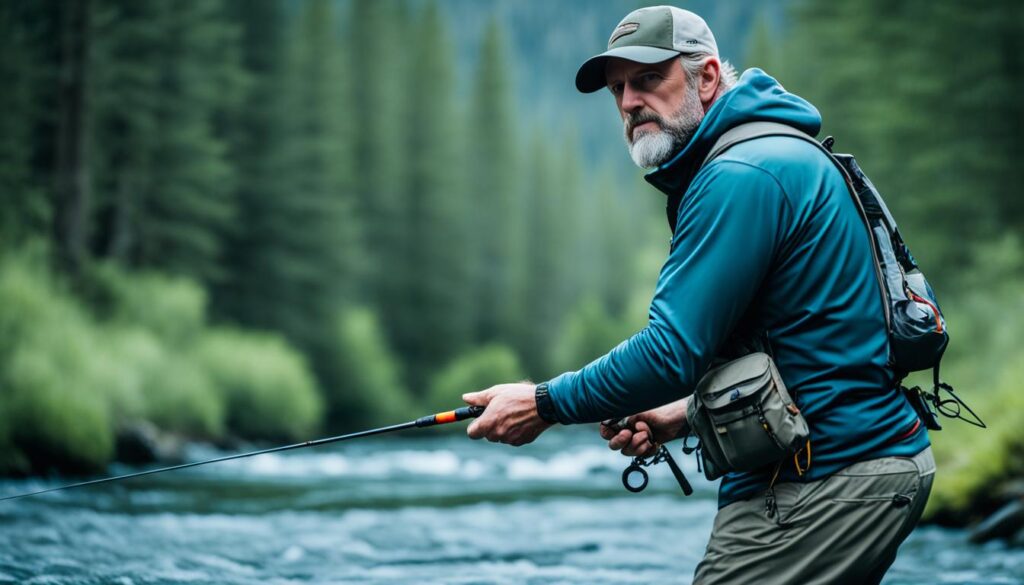
| Visual Indicators | Tactile Indicators |
|---|---|
| Abrupt movements in the floating line | Slight tug or resistance on the line |
| Deviation in the line’s path | |
| Inconsistent line curves or tip movement |
Synthetic Materials for Streamer Tying
When it comes to streamer tying, we have a plethora of synthetic materials at our disposal. These materials offer diverse properties that allow us to create flies with exceptional movement and flash. Let’s explore some popular options and their benefits.
Murdich Minnow – A Favorite Synthetic Pattern
One synthetic fly pattern that deserves our attention is the Murdich Minnow. This versatile pattern can be tied in various sizes and has been proven effective across different fishing scenarios. One key feature of the Murdich Minnow is its tail, which is made from a combination of Polar Flash, Krystal Flash, and Kanekelon fibers. This blend of synthetic materials provides the fly with incredible movement and attracts the attention of predatory fish.
The Versatility of Polar Flash
Polar Flash is another synthetic material that streamer tyers love to work with. This flash material is known for its exceptional shine and reflective qualities, making it ideal for adding flash and attracting fish. It comes in various colors, allowing us to create patterns that mimic different baitfish species and can be used in a wide range of streamer designs.
Exploring Other Synthetic Materials
Aside from the Murdich Minnow and Polar Flash, there are several other synthetic materials that can elevate your streamer tying game. Hackle Flash, for example, is a versatile material that adds volume, movement, and lifelike action to your flies. It is commonly used in streamers for smallmouth bass and trout, enticing strikes from these coveted targets.
Here’s a summary of the synthetic materials we’ve discussed:
| Material | Properties | Usage |
|---|---|---|
| Polar Flash | Shiny, reflective | Attractive flash material for streamer design |
| Hackle Flash | Volume, movement, lifelike action | Ideal for streamers targeting smallmouth bass and trout |
By incorporating these synthetic materials into your streamer tying repertoire, you can create flies that possess the necessary movement, flash, and attraction to entice fish. Don’t be afraid to experiment and combine different materials to achieve the desired effect. With the right materials and techniques, you’ll be well-equipped to tackle various fishing situations and reel in impressive catches.
Expanding Beyond the Woolly Bugger
Once fly tyers have mastered the Woolly Bugger, they can explore a whole world of advanced fly tying techniques and patterns. These techniques offer new opportunities for creativity and innovation, allowing tyers to expand their skills and create flies that are even more effective at enticing fish.
Complex Twist Bugger: Unleashing Creativity
One advanced technique that fly tyers can explore is the Complex Twist Bugger. This technique involves spinning together different synthetic materials to create a fly with bulk and movement. By combining materials such as flash, chenille, and marabou in unique combinations and colors, tyers can create flies that stand out and attract the attention of fish.
The Complex Twist Bugger offers versatility and customization options, allowing tyers to experiment with various materials and color schemes. The result is a fly that is visually appealing, dynamic in the water, and highly effective in tempting fish to strike.
Palmered Hackle Flies: Realistic Imitations
Another avenue for exploration in fly tying is the use of palmered hackle flies. These flies feature a hackle wrapped along the length of the hook shank, providing movement, flotation, and bulk. The palmered hackle technique allows tyers to create flies that imitate various aquatic insects and creatures, such as caddisflies, stoneflies, and leeches.
By selecting the right color and size of hackle, tyers can create flies that closely resemble the natural prey found in their target fishing waters. This level of realism can greatly increase the chances of enticing fish to strike. Palmered hackle flies are particularly effective when targeting selective trout or when fish are feeding on large insects or small baitfish.
With the Complex Twist Bugger and palmered hackle flies, fly tyers can take their skills to the next level and create flies that are not only visually captivating but also highly effective in fooling fish. These advanced fly tying techniques provide new challenges and opportunities for fly tyers to showcase their creativity and achieve exceptional results.
Lessons Learned from the Woolly Bugger
The Woolly Bugger, a staple in the world of fly tying, offers valuable lessons for aspiring fly tyers. This versatile pattern provides insights into tying proportions, mastering the pinch wrap technique, avoiding crowded heads, and achieving consistent results. By tying multiple Woolly Buggers, tyers can develop a keen sense of proportion and repetition, honing their skills and creating flies that are indistinguishable from one another.
One of the marks of a skilled fly tyer is the ability to consistently tie the same fly, replicating it flawlessly. The Woolly Bugger presents an excellent opportunity to practice this skill and achieve fly repetition mastery. Through repetition, fly tyers can refine their techniques, ensuring their flies have consistent proportions, materials, and finishes.
The Woolly Bugger also encourages creativity in fly tying. With its simplistic yet effective design, fly tyers are empowered to experiment with different materials, colors, and techniques. Whether it’s adding flash to the tail or incorporating new hackle variations, the creative possibilities are endless. This gives tyers the freedom to customize their flies and achieve the desired look and movement in the water.
“Tying the Woolly Bugger multiple times allows fly tyers to develop muscle memory and achieve consistent results. It’s like learning a musical instrument—practice makes perfect.”
Fly Tying Proportions
One of the key lessons the Woolly Bugger imparts is the importance of proper fly tying proportions. A well-proportioned fly not only looks aesthetically pleasing but also mimics the natural prey that fish are accustomed to. The Woolly Bugger’s simple design makes it easier for tyers to grasp the concept of proportionality, as the fly consists of a long hackle tail, a dubbed body, and a palmered hackle collar. By carefully observing these proportions and replicating them consistently, tyers can create flies that are visually appealing and enticing in the water.
The Pinch Wrap Technique
Another valuable lesson from the Woolly Bugger lies in mastering the pinch wrap technique. This technique involves pinching the hackle fibers between the thumb and index finger to secure them while winding the hackle around the fly. The pinch wrap ensures that the hackle fibers are evenly distributed and properly secured, resulting in a fly with a well-defined and consistent silhouette. Practice and attention to detail are vital in perfecting this technique.
Avoiding Crowded Heads
The Woolly Bugger also teaches fly tyers the significance of avoiding crowded heads. The head of a fly should be neat and proportionate to the rest of the fly, giving it a clean and attractive appearance. By carefully managing the materials and space at the head of the fly, tyers can create flies with well-structured and balanced heads. This attention to detail contributes to the overall appeal and fish-catching potential of the fly.
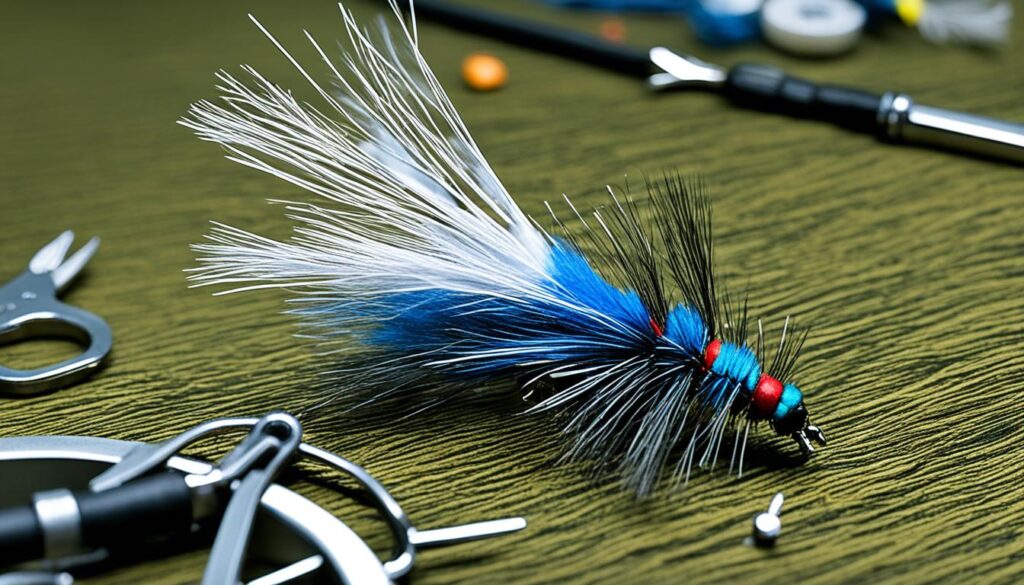
Conclusion
Mastering streamer ties is a journey that requires a deep understanding of various techniques, materials, and patterns. By incorporating the passive streamer technique into your fly fishing repertoire, you can unlock a whole new level of success. This unconventional retrieve, inspired by bass fishing tactics, allows for a slow and enticing movement that can attract larger fish in highly pressured waters.
Exploring synthetic materials is another essential aspect of creating effective streamer flies. With options like the Murdich Minnow, which utilizes materials such as Polar Flash and Krystal Flash, you can achieve excellent movement and flash in the water. These synthetic materials offer versatility and affordability, making them a popular choice among experienced fly tyers.
Expanding beyond the traditional Woolly Bugger opens up a world of possibilities in fly tying. Techniques like the Complex Twist Bugger and palmered hackle flies allow you to experiment with different materials, colors, and proportions. This exploration not only enhances your fly tying skills but also enables you to imitate various aquatic insects and creatures with precision.
Remember, fly tying is an art form that requires practice, observation, and refinement. Through consistent experimentation and the development of your own style and patterns, you can become an expert in streamer fly tying. Armed with knowledge and skill, you’ll be ready to take on the challenges of fly fishing, armed with expert streamer patterns that entice and excite the fish.
FAQ
What is the passive streamer technique?
The passive streamer technique is an unconventional retrieve that involves a slow retrieve with numerous pauses, imitating the movement of natural prey like crayfish and sculpin. This technique can lead to strikes during the pause when the fly is not moving at all.
How can I detect strikes with the passive streamer technique?
Detecting strikes with the passive streamer technique requires close observation of the line and subtle changes in line tension. By watching the floating line as the fly sinks or using the line’s tip or curves as indicators, anglers can detect strikes. Feeling line tension through the fingertips can also help detect subtle takes.
What synthetic materials are suitable for streamer tying?
There is a wide range of synthetic materials available for streamer tying. Popular options include Polar Flash, Krystal Flash, Kanekelon fibers, Hackle Flash, and more. These materials offer excellent movement and flash in the water and are relatively affordable.
What are some advanced techniques for streamer tying?
One advanced technique is the Complex Twist Bugger, which involves spinning together different synthetic materials to create a fly with bulk and movement. Another technique is using palmered hackle flies, which provide movement, flotation, and bulk to imitate various aquatic insects and creatures.
What can I learn from tying the Woolly Bugger?
Tying the Woolly Bugger can teach valuable lessons in proportions, the pinch wrap technique, avoiding crowded heads, and tying flies consistently. It allows fly tyers to develop a sense of proportion and repetition, ultimately becoming skilled at tying the same fly multiple times and making them indistinguishable.
